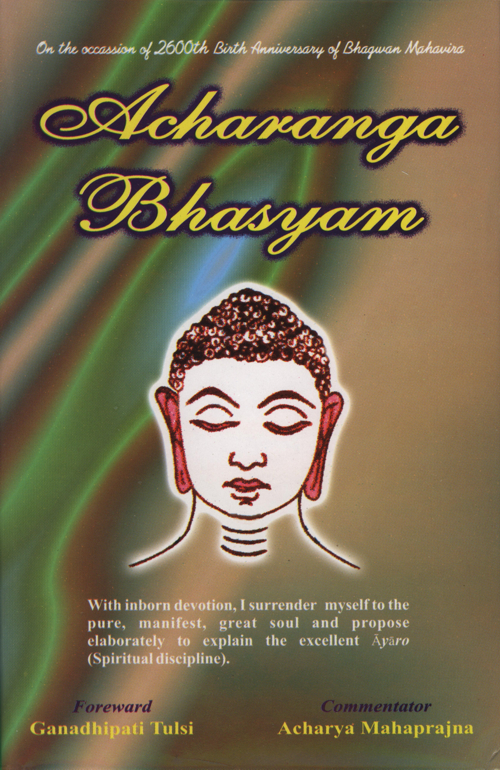2.148 se taṃ saṃbujjhamāṇe, āyāṇīyaṃ samuṭṭhāe.
The monk who has rightly understood (the above mode of treatment), carefully practises the commendable self-restraint.
Bhāṣyaṃ Sūtra 148
The person comprehending the aforesaid mode of treatment, should resolve that this should not be followed by a person of self-discipline. He should observe self-restraint, being vigilant and self-aware.
'Commendable' refers to the self-restraint consisting of knowledge, faith and conduct.
'Careful practice' stands for vigilance for the devout practice of knowledge, etc.
2.149 tamhā pāvaṃ kammaṃ, ṇeva kujjā na kārave.Consequently, he should not commit any evil deeds himself, nor get it done by others.
Bhāṣyaṃ Sūtra 149
He has cultivated vigilance for observing commendable self-restraint. For that reason, he should not commit any evil act, not get it done by others.
The Cūrṇi [1 ]explains the evil act as violence together with other misdeeds,
eighteen in all, upto the thorn of wrong faith. But here the issue under consideration is treatment involving violence. In the Sūtra, there is no mention of the approval of an evil act, but the Cūrṇi [2] includes that too.
2.150 siyā se egayaraṃ vipparāmusai, chasu aṇṇayaraṃsi kappati.
It is possible that he (the heretic) chooses a particular species of living being as permissible for the violence. [3] But in fact he indulges in violence to all the six classes of living beings.
Bhāṣyaṃ Sūtra 150
May be, sometimes, a person causes injury to a particular class of living beings due to non-vigilance. At that time, he virtually is engaging himself in injury to all classes of living beings just as a potter while making a jar primarily causes injury to the earth-bodied beings, but incidentally he happens to do injury to water, fire, air, vegetation, and even to mobile beings.
There is an alternative way of exposition. A person who causes injury to one living being virtually causes injury to all living beings, because he has not taken the vow of abstinence from injury to all living beings. A person who does not take the vow of abstinence from injury to any living being is liable to indulging in injury to all kinds of living beings. [4]
Ibid, p.89: sataṃ ṇa kujjā ṇo aṇṇehiṃ kārave kareṃtaṃ'paṇṇaṃ ṇāṇumodae, aṇumodaṇā akara-ṇākāraṇeṇa gahitā, ṇavae ṇavabhedeṇa.
One who causes violence to any one (system of living beings) can cause violence to anyone of the six systems of living beings (i.e. he causes violence to all the six systems). - In the background of this Sūtra, there underlies the ideology of non-violence and friendiness.
For a sādhaka, violence to all living beings is prohibited. This total prohibition creates the right temperament towards non-violence. If the killing of a particular system of beings is allowed and that of another system or systems of beings is prohibited, the right attitude towards non-violence cannot be friendly towards other systems of beings. In the epoch of Bhagavān Mahāvīra some friars used to justify themselves by saying that they killed no other living beings except beings of water-body. Some ascetics, belonging to the Śramaṇa tradition, used to profess, "we perpetrate violence only for food and for no other purpose."
When Bhagavān Mahāvīra's disciples used to pass through the paths of the jungle, there was a derth of 'inanimate water' (Cf. l.54-55). In many cases monks died of thirst. It is probable that a question might have been raised as to what harm might accrue from drinking animate water under those dire circumstances.
Bhagavān Mahāvīra, after weighing the pros and cons of the issue, observed that an aspirant whose mind was filled with a dormant feeling of violence even towards a single system of beings could not stride the path of absolute non-violence. Therefore, the sprit of friendliness should be very dense in the mind of a sādhaka. There should not remain the least trace of indulging in violence to any system of living beings.
The present Sūtra is in the context of acquisitiveness. Therefore, another interpretation of this Sūtra is possible in the context of acquisitiveness.
Violence, untruth, stealing, non-celebacy, acquisitiveness and post-sunset dinner - these are six avratas (i.e. infringement of the six vows). Is it possible that anybody practising anyone of these six in fringements can save himself from the non-observance of the other vows? Can any one who is acquisitive save himself from causing violence? Can any one practising violence save himself from acquisitiveness? In reply to all these questions Bhagavān Mahāvīra laid down the following principle - There are two fundamental evils - attachment and aversion. Violence, acquisitiveness etc. are nothing but their modifications. Motivated by attachment and aversion, if anyone practises acquisitiveness, he also commits violence etc. Complete forswearing of all the six avratas can be done jointly only and not separately, it is not possible that a muni may practise non-violence but not non-acquisitiveness or may practise non-acquisitiveness without practising non-violence. These great vows (i.e. mahāvratas) are practised simultaneously or violated simultaneously. They are acquired when pratyākhyānāvaraṇa-kasāya (which is one type of passion) has subsided, while they are violated when it comes into force. The mahāvratas cannot be observed or violated in any number less that six. Therefore the above principle can be enunciated in the context of acquisitiveness as follows:
One who violates the vow of non-acquisitiveness also violates other Mahāvratas, namely non-violence etc.
 Acharya Mahaprajna
Acharya Mahaprajna

